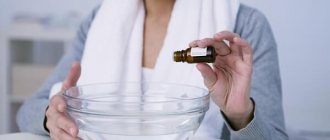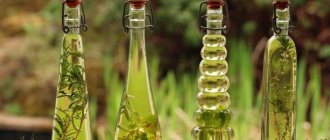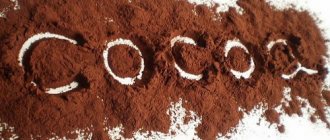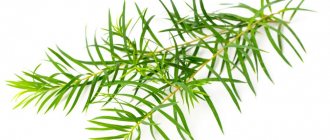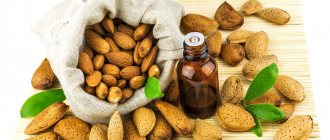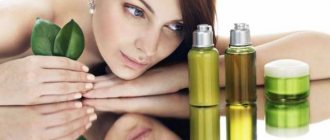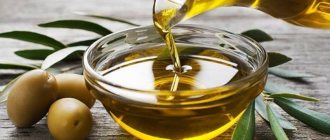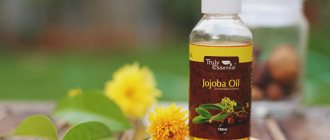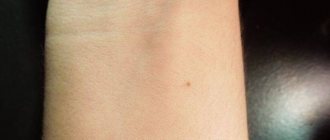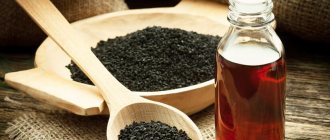Lavender essential oil is a universal antiseptic, anti-inflammatory and healing agent.
The use of lavender oil for the face is quite wide, because... even in small quantities it has a beneficial effect on all skin types. In addition to cosmetic products for dry and oily skin, lavender extract is included in masks for post-acne, wrinkles, acne and rosacea.
Composition and beneficial properties
Lavender essential oil contains the following components:
- derivatives of organic acids and terpenes (acetic, butyric, valeric, capronic, etc.), for example linalyl acetate and lavandulyl acetate;
- terpene alcohols (linalool, nerol, geraniol, lavanduol, eucalyptol, etc.);
- myrcene, ocimene, bergamotene, terpinene, caryophyllene and other terpene hydrocarbons;
- camphor.
Despite the fact that many of the beneficial properties of the product are due to the effects of camphor, in cosmetology only extracts from lavender varieties are used, which are characterized by a high content of terpenes and a low content of camphor.
When applied to the skin, lavender oil has the following effects:
- increases blood flow to the skin and improves microcirculation, stimulating the synthesis of fibrillar proteins (collagen and elastin);
- accelerates the healing of abrasions and microdamages of the epidermis;
- relieves itching of the skin, prevents flaking in dry skin and seborrhea, relieves irritation after burns;
- dries out wounds and acne;
- disinfects the skin, acting on fungi and bacteria as an antiseptic;
- relieves point inflammation;
- prevents the occurrence of scars after burns and acne;
- helps get rid of acne marks and hyperpigmentation;
- helps regulate sebum production.
The volatility of the ether allows you to combine aromatherapy and facial care. Regular use of the product can improve the condition of the skin, increase immunity and stimulate the regeneration of body cells after serious illnesses (including heart attack and stroke). Lavender oil has proven calming properties for chronic stress, anxiety and sleep disorders.
Benefits of lavender oil for skin
A natural product made from soft lilac lavender flowers has a complex composition. A unique set of components allows the use of a light oily liquid for various procedures.
Chemical composition:
- tannins explain the anti-aging, anti-inflammatory effect;
- linalool is a natural alcohol that has a drying effect;
- butyric and valeric acid soothe irritated skin, tone, slow down the aging process;
- resins perfectly heal wounds;
- Coumarin restores vascular elasticity and has an antitumor effect.
You can purchase oil at pharmacies and special retail outlets. The price of lavender essential oil depends on the manufacturer and ranges from 50 to 1500 rubles.
Mechanism of action on the skin
The mechanism of action of lavender ether on the skin is due to the biological properties of terpenes and terpenoid compounds, incl. camphor.
They have bactericidal, fungicidal and antiprotozoal effects. This prevents the development of secondary infection in case of skin damage and reduces the intensity of inflammatory processes (including acne).
The local irritating effect stimulates blood circulation in the upper layers of the skin. The influx of oxygen and nutrients accelerates tissue regeneration and the production of proteins that provide skin turgor.
The weak analgesic and antipruritic effects of the oil are due to the ability of camphor to selectively activate cold receptors in the skin. Gels with an admixture of menthol and mint oil have a similar property.
Rosemary essential oil
Rosemary essential oil for acne is usually chosen by those people who have a subtle scent. It's hard to disagree with this. Rosemary oil leaves a pleasant impression and awakens warm memories. Using it to fight acne on your face is a pleasure. Many people who have already tried this remedy on themselves note a certain effect of psychological comfort and calm. It seems that you no longer need to worry about skin imperfections, because you have a reliable assistant at hand!
Antibacterial effect
The product perfectly helps to cope with the inflammatory process and does not lead to any complications. Rosemary oil relieves irritation, eliminates dryness and flaking of the skin. Once you start using it, in the future, most likely, you will not want to change it to something else. Thanks to the antibacterial effect, the skin will very soon glow and take on a well-groomed, healthy appearance.
Tonic effect
Rosemary oil is quite effective against acne spots. In cases where they have to be removed with special solutions, essential oil copes with this task with a bang. It perfectly tones and moisturizes the skin, helps maintain a healthy, blooming appearance. A well-groomed person always strives to look attractive. He wants to make the right impression in society, and for this he must be able to like himself in the mirror. The tonic effect of essential oil with rosemary extract will help you achieve the best effect at minimal cost.
Contraindications
Contraindications to the use of facial oil are:
- hypersensitivity to lavender substance, frequent allergic reactions to other oils;
- 1st–2nd trimester of pregnancy;
- epilepsy, seizures;
- exacerbation of neurodermatitis;
- the presence of allergic rashes, wounds, ulcers and other extensive skin lesions;
- with caution: 3rd trimester of pregnancy, lactation, anemia, hypotension (low blood pressure), tendency to allergic reactions, bronchial asthma.
Before use, it is advisable to check the oil for allergies.
The incidence of allergic reactions and contact dermatitis when using lavender oil is 10–13%, so a contact test should be performed before applying the product to the face in any concentration.
To do this, apply a small amount of pure oil or prepared cosmetic product to a small area of the hand or face, leave for 10-15 minutes and rinse. If no unpleasant side effects (itching, redness, irritation, etc.) appear over the next 24 hours, the oil can be used on a larger surface of the skin.
When choosing a method of using a product, you must rely not only on the purpose of the mask, lotion or balm, but also on the feedback of the cosmetologist who observes the patient’s skin. If the epidermis is highly sensitive, it is better to avoid using oil (especially in its pure form) and use industrial cosmetics with a gentle composition.
Video
Essential oils solve various cosmetic problems and are used in the treatment of skin diseases. Popular in home self-care routines, lavender facial oil is an effective skin treatment. The essential extract has a pleasant aroma; it can be applied to the face in its pure form and used as part of masks. The main healing properties are healing and restoration of the epidermis.
Ways to use the oil
Lavender essential oil can be used in its pure form or as part of homemade cosmetics (creams, lotions, balms, masks and scrubs).
It is not recommended to enrich industrially produced cosmetics with oil, because due to local irritating effects, it increases the depth of penetration of the components of the products, incl. and harmful additives (preservatives, stabilizers, emulsifiers, etc.).
In its purest form
In its pure form, the oil can only be used spot on. To do this, you need to dip the tip of an ear swab or a cotton swab into the undiluted product, and then apply it to areas of inflammation, pimples, blackheads and other rashes (except allergic ones).
It is necessary to treat the face in this way 2 times a day until the defect disappears completely. To enhance the anti-inflammatory effect, you can mix tea tree and lavender oils in a 1:1 ratio in a dark glass container. Such a mixture will have less pronounced antiseptic properties, but will quickly relieve irritation and inflammation.
In case of extensive inflammation (for example, acne), it is recommended to treat the skin completely using a sponge. In this case, a concentrated mixture of light base oils (almond, peach kernels) and lavender extract is used. For 1 tbsp. base you need to take 5-10 drops of lavender substance.
Balm
Essential and base oils have good healing properties. A balm based on them is suitable for lubricating chapped lips, the face after a sunburn, and severely flaky areas of combination skin.
To prepare the balm you need to take:
- 5–10 g of natural beeswax;
- 1 tsp shea butter or cocoa butter;
- 5 drops of lavender oil;
- 2-3 drops of a tea tree-based substance;
- a few drops of vitamin E oil solution.
Solid components need to be melted in a water or steam bath, cool slightly and add liquid oils and vitamin E. Store the finished balm in a clean glass jar in the refrigerator. Shelf life: up to 2–3 months.
For oily and problem skin, this balm should be used sparingly and only with severe peeling, because the basic components are comedogenic.
Cream
An oil mixture with lavender extract can be used as a nourishing cream for dry and normal skin. To prepare it you need to take 2 tbsp. shea butter, jojoba, almond or peach kernels, add 1-2 drops of essential oil and 1 drop each of an oil solution of tocopherol and retinol.
It is advisable to apply the cream at night, immediately after thoroughly cleansing the skin using gel or foam with soft surfactants. The mixture of oils is applied to the face for 15–20 minutes, and excess that is not absorbed during this period is removed with a soft paper napkin.
Applying cream to face
Those with dry skin can use this cream daily, women with normal skin - 2-3 times a week. For oily, combination and problem skin, this procedure is not strictly prohibited, but it must be repeated no more than once every 2-3 weeks.
Oil cream helps well against fine wrinkles around the eyes. Massage around the eye area is carried out with your fingertips. Hands and face are thoroughly cleansed beforehand.
20–30 minutes after the procedure, the remaining product is removed with a soft cloth. If the cream is planned to be used in the eyelid area, it is recommended to reduce the concentration of essential oils.
Lavender oil can be used to enrich homemade creams and lotions. The concentration of the product should not exceed 1-2 drops per single dose of the base cosmetic product.
The following homemade creams can be used to care for different skin types:
- For dry skin. In a ceramic or glass bowl, mix 20 ml of glycerin and lanolin and stir. After the mass becomes homogeneous, add 30 ml of almond oil and 500-60 ml of avocado squeeze. Place the substance in a water bath, stir and add a few drops of lavender extract. Cool and transfer to a small glass jar, use 1-2 times a day. Store for no more than 1–2 weeks.
- For normal skin. Place 2-3 tbsp in a water bath. l. coconut oil or a mixture of cocoa and coconut extracts. Add 4 drops of lavender, geranium and tea tree oil to the liquid oil base. Use and store in the same way as for dry skin.
- For oily skin. For problematic and oily epidermis, use a lighter version of the cream. To prepare the composition you will need 1.5–2 tbsp. peach or grape seed oils, a little emulsifier from a home cosmetics store, 2 drops of an orange-based substance and 3 of lavender. Apply the cream once a day after deep cleansing.
Tonic
This product is designed to moisturize the skin and improve complexion. To prepare lavender tonic, you need to take 0.5 liters of distilled or thermal water, bergamot, tea tree and lavender oils (1 drop each).
The container with water and oil is tightly closed with a lid and shaken vigorously. After this, the liquid is left in a dark place for a week, shaking it periodically (up to 3 times a day).
The finished tonic can be used 1-2 times a day. Before use, shake the bottle with the product to create an emulsion.
Peeling
Extracts and essential oils of plants increase the effectiveness of home peeling, because... penetrate deeply into cleansed skin and have an anti-inflammatory and antiseptic effect.
The base of the peeling mixture is selected depending on the skin type:
- for the dry type, a mixture of coarse sea salt and olive oil (1:1) is suitable; essential essences are added to it at the rate of 1-2 drops per 2-3 tbsp;
- for the normal type, you should take avocado oil and rice, previously crushed in a coffee grinder (1:1), lavender extract is added to them in a ratio of 2-3 drops per 3-4 tablespoons of the mixture;
- For oily, combination and problem skin types, blue clay diluted with thermal water is suitable, and oil is added in the same amount as for dry skin.
The finished peeling mixture is applied to the face and distributed with massage movements for 5 minutes. After this, you need to rinse off the product and thoroughly moisturize the skin with cream.
To stimulate regeneration processes in the epidermis without harming the skin, you need to peel no more than 1-2 times a week (for dry skin - 1 time a week).
Lavender body oil
The range of uses of the natural product made from lavender flowers is wide - from healing compositions for wounds and erosions that are difficult to treat, to soothing baths. The delicate oily mixture rarely causes allergies and enhances the effect of other components on the skin.
For burns and non-healing skin ulcers, use these formulations. The products have excellent wound healing, aseptic, and softening effects.
Remember:
- recipe number 1. Equal parts of pine, sea buckthorn, lavender oils. Treat the affected areas several times during the day;
- recipe No. 2. You will need a mixture of oils: cypress - 5 ml, lavender - 15 ml, olive - 10 ml;
- recipe No. 3. A lavender bath is recommended for large areas of moderate burns. Be sure to add a few tablespoons of cream, sour cream, or yogurt to the water to avoid irritation from the concentrated oil. The duration of stay in water with a temperature of 37–38C is 15 minutes. For a bath of water you will need 100 ml of an oily product made from lavender flowers.
How to get rid of freckles on your face forever? We have the answer!
In this article, learn all about the uses of argan oil.
Follow the link and read interesting information about the human papillomavirus in women and men.
Mask recipes
In addition to tonic, cream and scrubs (peeling), lavender oil is also added to nourishing, moisturizing and toning face masks. Homemade masks with lavender help cleanse the skin, get rid of hyperpigmentation and acne, and prevent the appearance of wrinkles and flaking.
For acne
The composition of the mask for acne and acne differs depending on the fat content of the epidermis:
- For dry and normal skin, you need to take 1 yolk, lightly beat it with a fork or whisk, and then add tea tree and lavender based substances (2 drops of each oil).
- To care for oily and combination skin, replace the yolk with white. The ratio of oils does not change, but you can add 1 drop of thyme extract (thyme).
- For problem skin, a mixture of lavender oil (1-2 drops), 2-3 drops of salicylic alcohol and 1 tsp. oatmeal or ground flakes.
To enhance the effect of the mask, before the procedure, the face needs to open the pores with a decoction of calendula. To do this, sit over a pan with a hot decoction of the plant, cover your head with a towel and steam your skin for 10 minutes. The mask is applied to damp skin.
For wrinkles
The following masks are suitable for caring for aging skin and smoothing out wrinkles:
- With yogurt. Beat 1 egg white into a strong foam and heat 1 tsp. honey Cool the honey and mix it with the protein. Add 1 tbsp. natural unsweetened yogurt and 2-3 drops of lavender. Stir and apply to face for 15 minutes. Rinse off with lukewarm chamomile infusion or water.
- With sea buckthorn. Mix sea buckthorn oil with semolina or corn starch. The consistency of the base mixture should be convenient for application. Add 5 drops of oil retinol and 2-3 drops of lavender. Apply to face, leave for 15 minutes and rinse with water or herbal decoction.
- With an apple. Bake 1 medium apple in the microwave or oven. Peel it and separate the soft pulp. Grind the pulp into puree, add 2 tsp. a mixture of olive oil and honey. Add 2-3 drops of lavender. Apply for 10-15 minutes, then carefully remove with a sponge, and rinse off any remaining residue with cool water.
Honey-based masks should not be used for rosacea.
From scars
Lavender masks lighten post-acne spots and partially smooth out scars and burn marks. To stimulate skin regeneration, you need to mix 1 tbsp. wheat germ oil and 0.5–1 tsp. lavender. It is recommended to wipe scars and acne marks locally to avoid facial burns.
The procedure should be carried out 2-3 times a day.
For rosacea
To strengthen small blood vessels and eliminate mesh on the face (rosacea), the following mask is used:
- Separate the egg yolk from the white. Beat the yolk until light creamy.
- 1 tsp Mix almond or jojoba squeeze with lemon, lavender and rose essential oils (1, 2 and 3 drops, respectively).
- Combine the butter mixture and yolk.
For dry skin
To care for dry and flaky skin, masks with an oil base are used. The most active nutrition is provided by thick oils (shea, coconut or cocoa). In the cold season, you should use dense, thick bases, and in the warm season, lighter oils (almond, avocado, peach kernels, etc.).
The most effective are the following masks:
- Mix 2 tbsp. unsweetened yogurt or heavy cream and 1 tsp. Avocado squeezes. Add a few drops each of lemon juice and lavender extract. Apply to the surface of the skin for 5-10 minutes.
- Take 1–2 tsp. cream, 1 tsp. melted coconut oil and 1 drop of lavender. Mix all ingredients. Spread the homogeneous mixture over your face and leave for half an hour.
Both masks must be washed off with warm water.
For oily skin
For oily skin, it is recommended to use masks with cosmetic clay for care. They reduce sebum production, cleanse pores of sebaceous plugs and blackheads, reduce inflammation and mattify the face.
To prepare the mask you need to take:
- 2 tbsp. blue, white or black clay;
- 0.5–1 tsp. lemon juice;
- 4-6 drops of a lavender-based substance (if desired, you can add tea tree oil);
- mineral or thermal water.
Cooking method:
- Dilute the clay with water to the consistency of thick cream.
- Add lemon juice and essential oils.
- Apply for 15–20 minutes, rinse with lukewarm calendula decoction. Spray your face with the remaining thermal water.
After the procedure, lubricate your face with a light moisturizing cream.
Who is recommended for lavender oil treatments?
Indications:
- peeling, itching, irritation of the epidermis;
- sensitive skin of the face and body;
- problematic, inflamed skin;
- fading, aging skin;
- presence of pimples, comedones, acne;
- keratinized feet;
- increased sweating of the legs and body;
- regular care for all types of skin.
For medicinal purposes for:
- dermatoses;
- eczema;
- psoriasis;
- rosacea;
- acne;
- viral and fungal infections; (Read about fungus on your hands here; about fungus on your feet in this article);
- sunburn;
- furunculosis
- insect bites: snakes, mosquitoes, mosquitoes;
- hair loss.
Contraindications:
- individual sensitivity to components;
- taking iodine and iron-containing drugs.
How to remove brilliant green from skin after chickenpox? Find out the most effective methods and recipes.
Read recipes for homemade anti-cellulite wraps with mustard on this page.
You can also learn about dermatoses on our website. Read about allergic dermatitis here; about contact here; about oral in this article.
Cosmetical tools
Today, a variety of cosmetics based on lavender oil are on sale, not only for the face, but also for the body and hair.
You can also purchase pure oil that is not a medical product.
For example, such oils are produced under the trademarks “Crimean Rose”, “Aromatica” and a number of others.
In pharmacies or cosmetic stores you can easily find products with lavender oil not only from Russia, but also from Bulgarian, French, and Italian manufacturers.
So, as a means for rejuvenating and healing facial skin, lavender oil is a valuable natural preparation. It is gentle on sensitive skin and eliminates irritation. It dries out oily, acne-prone skin and kills microorganisms.
Lavender oil saturates dry and dull skin with beneficial substances, stretches wrinkles and even scars. In addition, lavender helps eliminate toxins and accelerates the treatment of fungal diseases, psoriasis, and eczema.
Colorless lemon balm oil has a sharp, invigorating, fresh aroma with hints of lemon.
A distinction should be made between 100% natural essential oil and oil obtained by processing lemon or lemongrass oil over lemon balm herb.
In the latest copies, the percentage of lemon balm oil is about five to seven percent.
Such differences in manufacturing affect the price of the product.
This product is valued in cosmetology for its effective fight against acne.
Thanks to its action to normalize the functioning of the sebaceous glands, essential oil promotes a speedy recovery of the skin. This oil will work most effectively on oily skin.
DETAILS: Pubic papillomas in men and women, photos, causes, treatment
Possible negative effects when used on sensitive skin. A test for allergic reactions is necessary. The oil is contraindicated for pregnant women.
